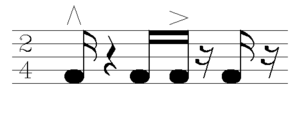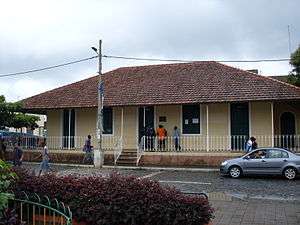Tabanka
| Tabanka Tabanca | |
|---|---|
| Cultural origins | Cape Verde |
| Typical instruments | Vocals, hornet, drums and guitar. |
Tabanka (Cape Verdean crioulo name of tabanca) is a musical genre of Cape Verdean music
As general music

As general music, tabanka characterizes by having an allegro, a binary compass,[1] and traditionally being melodic only.
Rhythmically has four variants of tabanca including tabancas of Várzea, Achada Grande, Achada de Santo António (three neighborhoods of the city of Praia) and Chã de Tanque in Santa Catarina[2] Tabanka today have been composed in other forms by recent composers and musicians.
History

The word "tabanka" existed in Portuguese texts in around the 16th century. The word was likely originated from some of the African languages, mainly the westernmost part of West Africa, that time, it was used to build and design fortifications by Portuguese navigators in the coast of Guinea (now roughly Guinea-Bissau) in the Guinea-Bissau Creole, the word "tabanka" or "tabanca" means "locality" or "neighbourhood", in Cape Verde, it achieved a different significance.
The origin of tabanka is unknown, Semedo and Turano,[3] one of the hypotheses for the rise of tabanka into the definition in the 18th century.
Although tabanka was hostile by the Administration (due to the uprising by the slaves) and the church (not very "catholic") in the early years. In 1896, tabanka became prohibited in Praia by the colonial governor Serpa Pinto. Performance was banned in urban centers and the genre was slowly disappearing. The ban lasted until Cape Verdean independence. Along with funaná and batuque, tabanka was a symbol for the struggle for Cape Verdean independence. Afterwards there were attempts to revive several Cape Verdean music styles. It did not met the success of the revival of funaná in the 1980s or batutue in the start of this century.
The Museu da Tabanka (Tabanka Museum) in Assomada in the middle of Santiago Island features about its music style.
Examples
- "Tabanca" by Os Tubarões
performed by Os Tubarões on the album Tabanca (1980) - "Puêra na odju" by Zezé di Nha Reinalda
performed by Finaçon on the album Farol (Ed. Mélodie — 1992) - "Tabanca" by Orlando Pantera
- "Nha nobo", traditional
performed by Simentera on the album Barro e Voz (Ed. Mélodie, Paris — 1997)
See also
Notes
Bibliography
- Richard A. Lobban Jr et Paul Khalil Saucier, "Tabanka, tabanca", Historical dictionary of the Republic of Cape Verde, Scarecrow Press, Lanham, Maryland ; Toronto ; Plymouth, 2007, p. 219-222 ISBN 978-0-8108-4906-8
- Monteiro, Vladimir, Les musiques du Cap-Vert (Music of Cape Verde), Chandeigne, Paris, 1998, p. 117-118 ISBN 2-906462-48-9
- Sabrina Requedaz et Laurent Delucchi, Cap-Vert (Cape Verde), Guide Olizane, Geneva, 2003, p. 53
- Semedo, J. M. M.; Turano, Rosário (1997). O ciclo ritual das festividades da tabanca.
External links
- About Cape Verdean musical forms that exists, article by Margarida Brito (1998) in pdf (Portuguese)
- Tabanca – O berço da nossa cultura - Description of performance of tabanka festivals (Portuguese)
- Museu da Tabanka (Portuguese)
- Music and Cape Verdeans in Lisbon (Portuguese)